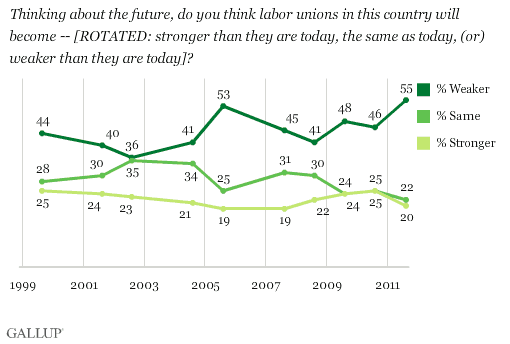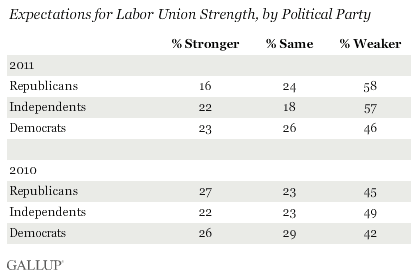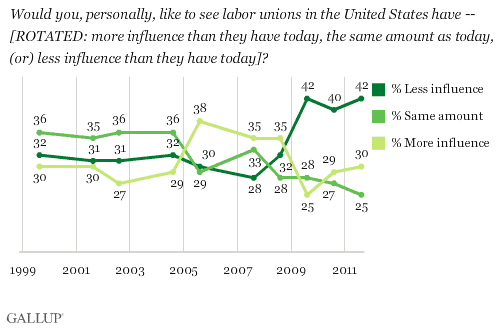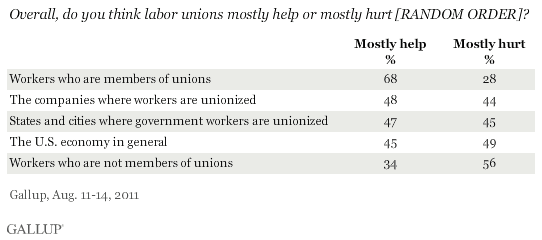PRINCETON, NJ -- A majority of Americans, 55%, think labor unions will become weaker in the future than they are today. That is up from 46% last year and the highest Gallup has measured since it first asked the question in 1999.

These results are based on Gallup's annual Work and Education poll, conducted Aug. 11-14. Americans have always been more likely to expect labor unions to weaken rather than strengthen, but not to as high a degree as they do this year.
The new high could be a response to the battles between state governments and public employee labor unions that have occurred in several states this year. As state governments have struggled to balance their budgets, public employees, many of whom are unionized, have been forced to accept cuts in pay or benefits. In Wisconsin, the government passed legislation to limit the scope of what public unions can bargain for.
All party groups generally expect unions to become weaker in the future, with Democrats slightly less likely to say this. Since last year, Republicans and independents have become significantly more likely to believe unions will weaken in the future, with a smaller increase in the percentage of Democrats holding this view.

Americans Want Unions to Have Less, Rather Than More, Influence
Forty-two percent of Americans would personally like to see unions have less influence than they have today, tying the high from 2009. Thirty percent want unions to have more influence, and 25% would prefer no change.
The last three years mark a significant shift in what Americans want to see from labor unions. Since 2009, at least 4 in 10 Americans have preferred a reduction in union influence, compared with no more than 32% from 1999-2008. From 2005-2008, Americans were more likely to say they wanted unions to have more, rather than less, influence.

Republicans are solid in their preference for wanting unions to be less influential, while independents lean in that direction. Democrats lean the other way, with 45% wanting unions to be more influential.

Americans See Unions as Mainly Benefiting Unionized Workers
When asked to assess the impact of unions on various groups or entities, Americans clearly believe unions mostly benefit workers who are members of unions, and mostly harm workers who are not union members. The public renders a mixed verdict on whether unions mainly help or hurt companies where workers are unionized, states and cities where government workers are unionized, and the U.S. economy in general.

Americans were significantly more likely to see unions as helping rather than hurting the economy and the companies where workers are unionized from 1999-2006 than they are today. In 2009, as Americans' general views of unions reached a new low, so did their views of whether they help the economy and businesses.
Implications
Americans' views of labor unions in the past three years are the least positive they have been, with historically low approval ratings and record highs in wanting unions to be weaker in the future and expecting that to occur. This marks a shift from the past, when Americans generally held positive views of labor unions and their impact on the economy and workers.
The more negative views of unions could be tied to the health of the economy. Gallup also found downturns in union approval in the 1970s and early 1980s, when the economy was struggling. The expectation for weakening union influence may also reflect the realities of union strength in a weak economy, as public employee unions, typically some of the strongest and most successful unions, have had to accept reductions in member benefits to help governments stay within their budgets.
Survey Methods
Results for this Gallup poll are based on telephone interviews conducted Aug. 11-14, 2011, with a random sample of 1,008 adults, aged 18 and older, living in all 50 U.S. states and the District of Columbia.
For results based on the total sample of national adults, one can say with 95% confidence that the maximum margin of sampling error is ±4 percentage points.
Interviews are conducted with respondents on landline telephones and cellular phones, with interviews conducted in Spanish for respondents who are primarily Spanish-speaking. Each sample includes a minimum quota of 400 cell phone respondents and 600 landline respondents per 1,000 national adults, with additional minimum quotas among landline respondents by region. Landline telephone numbers are chosen at random among listed telephone numbers. Cell phone numbers are selected using random-digit-dial methods. Landline respondents are chosen at random within each household on the basis of which member had the most recent birthday.
Samples are weighted by gender, age, race, Hispanic ethnicity, education, region, adults in the household, and phone status (cell phone only/landline only/both, cell phone mostly, and having an unlisted landline number). Demographic weighting targets are based on the March 2010 Current Population Survey figures for the aged 18 and older non-institutionalized population living in U.S. telephone households. All reported margins of sampling error include the computed design effects for weighting and sample design.
In addition to sampling error, question wording and practical difficulties in conducting surveys can introduce error or bias into the findings of public opinion polls.
View methodology, full question results, and trend data.
For more details on Gallup's polling methodology, visit www.gallup.com.
